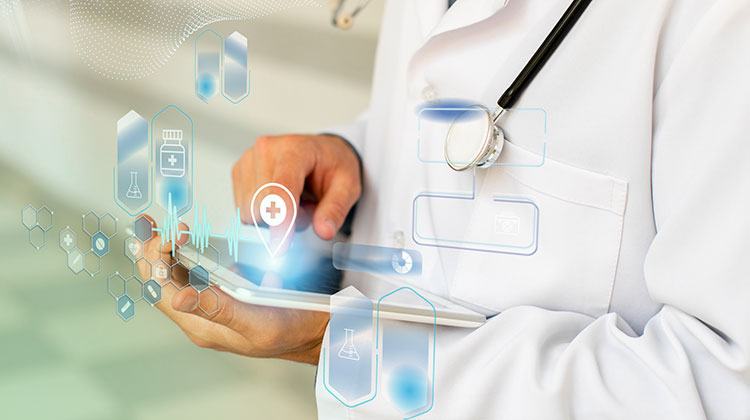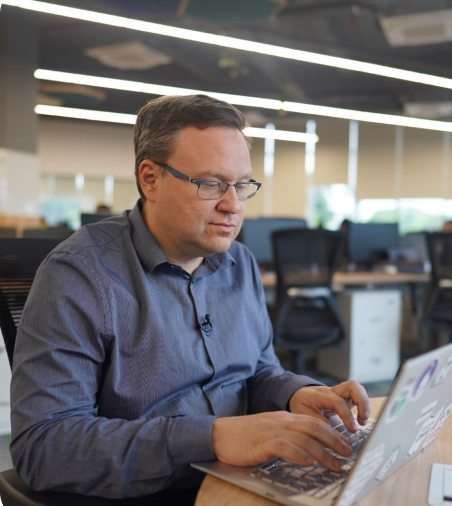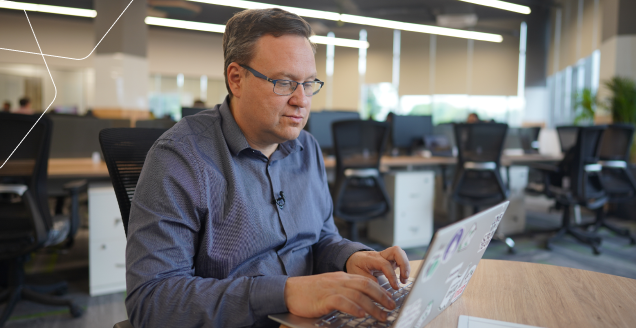The Benefits of Healthcare IoT

Healthcare IoT solutions have rapidly changed patient care over the last decade.
The Internet of Things (IoT) has boosted healthcare thanks to the availability of high-speed internet, improved wearable devices and sensors, big data, and advanced artificial intelligence (AI) and machine learning technologies.
As a result, doctors and clinicians have more options for monitoring their patients’ health.
IoT solutions also help healthcare providers increase patient engagement in their own health path.
This article looks at the benefits of Healthcare IoT for physicians, patients, and health organizations.
What Is Healthcare IoT?
Healthcare IoT refers to a medical device (or a network of devices) that communicates and shares data over the internet with other devices and, ultimately, the users of those devices.
For example, healthcare IoT keeps patients connected to their care team after leaving the doctor’s office or hospital. It also enables devices to talk to each other within the care setting, which in turn helps providers make better decisions for their patients.
IoT has multiple healthcare applications, such as medication monitoring, hospital supply management, AI-enhanced diagnoses, orthopedic rehabilitation, and countless other applications.
Possibly the most common use of healthcare IoT is telehealth.
Telehealth
Although unpopular before 2020, telehealth adoption got a shot in the arm from the Covid-19 pandemic.
That’s not to say telehealth solutions didn’t exist prior to 2020, but their usage was low.
After the lockdown began, telehealth skyrocketed.
To avoid spreading the virus, doctors closed their offices and began seeing patients via video calls and HIPAA-compliant telehealth software.
Patients found they liked it. It saved them time. It was easier than going into the doctor’s office. And it reduced their exposure to other sick patients.
Even when the pandemic ends, telehealth will likely continue to be popular. Telehealth solutions have the potential to eliminate many routine office visits and follow-up appointments.
This feature will be especially valuable in rural communities and other areas where travel to a medical facility is challenging. Telehealth can literally be a lifesaver in these regions – particularly when coupled with remote patient monitoring applications.
Remote Patient Monitoring
Until just a few years ago, a patient with a chronic medical condition would have to travel to a healthcare facility several times a month for checkups.
The inconvenience of these checkups often caused patients to miss appointments—which, in turn, could result in them getting very sick.
Now providers can use healthcare IoT software to monitor patients remotely. These remote monitoring solutions create a gateway for critical communication between patients and their doctors.
Care providers can check vital statistics such as blood pressure, pulse, weight, glucose, and temperature—without the patient leaving home.
Some remote monitoring solutions alert care staff if a patient’s vitals change drastically. The provider can then take remedial action to address the patient’s health needs.
Wearable Devices
Remote monitoring coupled with wearable sensors or consumer wearable devices can augment care during for people with chronic conditions that need regular checkups.
For example, cancer care can benefit from remote patient monitoring. Such a system could help maintain patient health as they undergo weeks-long chemotherapy treatment. In addition, cancer patients in rural environments may have limited access to care. These patients would especially benefit from remote monitoring.
Remote monitoring is particularly critical for people who suffer from COPD, diabetes, and other lifelong diseases. Many such conditions can quickly deteriorate. When care teams get consistent updates on a patient’s disease state, however, they can help the patient avoid complications and hospitalizations.
One of the critical metrics for Covid-19 patients is their blood oxygen level, for example. If this level dips below 92%, it may require intervention. At 88% or below, the patient requires immediate hospitalization. Patients wearing IoT-enabled oximeters can be monitored remotely, allowing them to recover at home unless their blood oxygen levels decline.
Regardless of the health condition, remote patient monitoring and care management systems using IoT for healthcare provide a safety net for at-risk individuals living at home.
Driven by the increasing role of IoT and the shift toward home-based healthcare devices, the global market for remote patient monitoring is expected to reach $62 billion by 2027. Additionally, 53% of US hospitals have a remote patient monitoring system.
Soon, healthcare IoT may even interface with popular fitness trackers or the Apple Watch, which can already monitor several health indicators.
Big Data and Healthcare IoT
Healthcare IoT relies on collecting and combining internal and external data from several sources. And that means big data.
The regulatory push for greater interoperability means that healthcare organizations and their IT systems are sharing more data—both internally and with other external healthcare providers.
The goal of these interoperability mandates is not only to provide a continuum of quality care for individual patients, but also to improve the health of the population at large.
With big data, it’s easy to imagine great leaps forward in both the healthcare industry and medicine in general. But giving providers and researchers access to this massive collection of accurate and relevant real-time data means they’ll also need tools to work with it.
That’s where artificial intelligence (AI) and machine learning come in.
AI and Machine Learning in Healthcare
The healthcare industry is starting to explore the benefits of artificial intelligence (AI) and machine learning for collecting and analyzing high-quality health data.
When coupled with AI and machine learning algorithms, healthcare IoT solutions can quickly analyze data to help predict adverse health outcomes and give physicians more accurate diagnoses.
Healthcare workers have a lot on their plate. Although their goal is to provide quality care, they have massive amounts of health data and medical records to contend with.
Machine language solutions can scan electronic health records (EHRs) and other biomedical data to quickly provide accurate answers to busy care providers.
Health data and EHRs often are stored as complex unstructured data. While this is difficult for a human to interpret and access, AIs can find, retrieve, store, and standardize medical data regardless of the format.
AIs enable physicians to deliver accurate, tailored treatment plans to their patients faster. It frees them from searching, identifying, collecting, and transcribing the solutions they need from mountains of EHRs.
A few ways AI is being used in healthcare include:
- Analyzing medical imaging
- Developing new medicines and treatments
- Diagnosing and forecasting complex health conditions
- Assisting emergency medical staff
- Contributing to cancer research and treatment
- Predicting chronic disease
- Discovering and developing genetic medicine
AI-powered healthcare IoT has enormous potential for delivering improved healthcare outcomes for patients. Furthermore, by enabling early detection and intervention, AI can help prevent costly emergency room visits and unnecessary hospitalization, thereby lowering the cost of care.
Conclusion
As a result of healthcare software development, care providers have more options for monitoring their patients’ health, engaging and educating patients, and increasing the quality of their healthcare services.
Healthcare IoT solutions will continue to expand and improve the ability of health organizations to meet patients’ needs for telehealth and remote monitoring, with big data and AI assisting in the delivery of this care.

